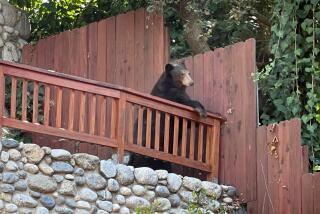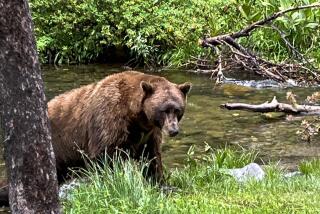A Hearing Test That Could Have Quite a Bearing
- Share via
SAN DIEGO — Shikari is making that huffing sound that polar bears make when they’re checking out their surroundings.
The 12-year-old, 550-pound Ursus maritimus is also eyeing the four humans watching her from behind steel bars. Her thick black nose is twitching with the scent of her visitors.
But most important, Shikari is listening -- listening to tones being generated by a computer. Her small rounded ears perk up as each tone is sounded.
She has been trained to press her nose on a pad when she hears a tone. Through the bars, researcher JoAnne Simerson gives her a tasty brownish morsel called omnivore chow. It’s all for science.
Shikari and her twin sister, Chinook, are part of the first-ever study of polar bear hearing. The project began late last month at the San Diego Zoo, in cooperation with SeaWorld.
With the oil and gas exploration industries looking to expand drilling activity in Alaska, researchers want to discover what the noise from such exploration would do to polar bears, particularly females who are pregnant or are nursing cubs.
Funding for the study, up to $60,000, comes from BP, formerly known as British Petroleum. The Louisiana-based conservation group Polar Bears International acted as middleman for the grant.
After testing of Shikari and Chinook is finished, similar tests may be done on SeaWorld’s polar bears: Charly, Szenja and Snowflake. The zoo and SeaWorld worked together before on a study of polar bears’ reproduction cycles.
Shikari and Chinook were chosen for the current study because researchers are primarily interested in adult females. The zoo’s other polar bears, the female Tatqiq and male Kalluk, are only 6 years old and not yet sexually mature.
Although the hearing study is being underwritten by the oil industry, researchers say they are not taking sides in the hot issue of expanding oil drilling in Alaska. The findings will be printed in a scientific journal late next year.
“It behooves both sides of the argument to know what the reality is,” said Megan Owen, a lead researcher with the zoo’s Conservation and Research for Endangered Species facility. “We’re just gathering the data.”
Polar bears are the world’s largest land-based carnivores, but the sum of knowledge about them is spotty, researchers say. It’s known that a polar bear can smell a seal 20 miles away and can swim at speeds up to 6 mph, but estimates of their hearing capacity are largely guesswork.
“We know almost nothing about the hearing of bears, great cats and ungulates [hoofed animals],” said Ann Bowles, bio-acoustic specialist at the Hubbs-SeaWorld Research Institute. “We’re in a state of blankness.”
There have been some tests in the wild to gauge what bears can hear. In one test, a researcher tooted a high-pitched dog whistle near a group of brown bears.
“It created a stampede,” said Scott Schliebe, a polar bear specialist with the U.S. Fish and Wildlife Service who is based in Anchorage.
Still, one test in the wild does not make for a scientifically valid conclusion. Schliebe and other polar bear specialists are eagerly awaiting the results of the San Diego Zoo research.
Polar bear specialists estimate that upward of 25,000 polar bears roam the Arctic and that about 2,000 of them live near the North Slope oil fields. The federal government is evaluating a request from a conservation group to list the polar bears as a threatened species, one step away from endangered.
Since the early 1960s, the government has insisted on a one-mile buffer zone between oil drilling and areas where polar bears are known to congregate.
“We’ve retained [the one-mile rule], but we don’t know how effective it is,” Schliebe said.
As development pushes closer to areas where female polar bears go to give birth, the one-mile limit takes on added significance.
“It was really just an arbitrary decision to put it at one mile,” said Steven Amstrup, a polar bear specialist with the U.S. Geological Survey, also based in Anchorage. Amstrup is an expert on the polar bear maternity denning sites in Alaska’s Arctic National Wildlife Refuge.
Depending on what the research finds, he said, the one-mile rule may have to be changed.
“A mile may prove sufficient in some cases; some cases it may not be needed; and in others, more than a mile may be needed,” Amstrup said.
Three days a week, Chinook and Shikari are tested, individually, with a variety of tones. The goal is to test them on 1,000 tones, judging whether they can hear each one and how quickly they react. Most of the tones are within the human range of hearing; some are not.
Among other things, the bears’ facial movements are noted. The two animals’ hearing is about the same, but Chinook is more placid in her temperament while Shikari is more methodical in her evaluation of her surroundings and seemed to be looking at the four humans as potential lunch.
Robert Buchanan, president of Polar Bears International, said he hopes that the San Diego research spurs other projects, both in zoos and in the wild.
“That’s the great thing about research,” he said. “Once it’s over, it opens about a dozen other questions.”
Buchanan is in the Canadian town of Churchill on Hudson Bay watching the annual migration of the polar bears. Several research projects are underway, including studies of polar bear whiskers and polar bear DNA.
“It’s like a zoo up here; it’s great,” he said.
More to Read
Sign up for Essential California
The most important California stories and recommendations in your inbox every morning.
You may occasionally receive promotional content from the Los Angeles Times.













